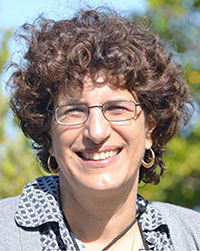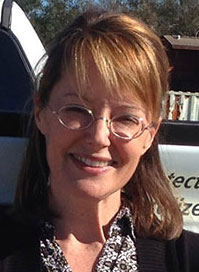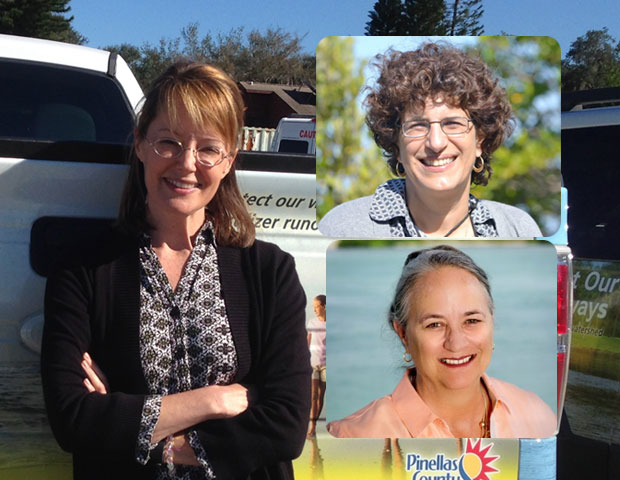It’s easy to understand why kids grow up and want to be movie stars, athletes or rock stars. But when today’s women environmental scientists began their careers – not only wasn’t it glamorous – most people didn’t even know why it should matter. In fact, before 2000, girls were commonly expected to be “bad at science.” Happily, today it’s a different story. We’re taking a closer look at what made eight of our regions’ top environmental scientists excel. This is the second part of three articles about eight amazing women who have helped make Tampa Bay a healthier ecosystem.
1. Describe your job and what makes it rewarding.
 Sarina Ergas, Professor, University of South Florida, Department of Civil & Environmental Engineering — Sabrina has taught environmental engineering to graduate and undergraduate students for 20+ years.
Sarina Ergas, Professor, University of South Florida, Department of Civil & Environmental Engineering — Sabrina has taught environmental engineering to graduate and undergraduate students for 20+ years.
I divide my time between teaching, research and service to the community and the profession. My favorite class to teach is Capstone Water Resources/Environmental Engineering Design, where teams of senior level Civil & Environmental Engineering students work with local municipal agencies on real world projects. I also have an active laboratory where my students carry out research in the field of Environmental Biotechnology. Some of the projects we are working on now have to do with improving onsite wastewater treatment (aka septic) systems to remove nutrients, converting livestock waste and yard waste to bioenergy and improving aquaculture systems to improve the sustainability of farmed fish production.
My students and I have had an impact on water and wastewater treatment and biological air pollution control through our research. Many of my former students are now environmental professionals working to improve the environment.
 L. Kellie Dixon, PhD, senior scientist, Ocean Technology Program, Mote Marine Laboratories — Kellie’s job involves design, execution, and interpretation of data from experiments addressing environmental problems.
L. Kellie Dixon, PhD, senior scientist, Ocean Technology Program, Mote Marine Laboratories — Kellie’s job involves design, execution, and interpretation of data from experiments addressing environmental problems.
My projects are generally collaborative. The interaction and work with other talented investigators never fails to reward and improve our science. I am really pleased with the outcome of our work to establish seagrass light requirements. Funded by the SWIM Program of SWFWMD, Jay Leverone and I empirically determined light received at the deep edges of seagrasses in Tampa Bay for a year. It was technically and logistically challenging, the analysis of the data had several interesting “wrinkles” to solve, and the results have been widely used by multiple agencies to protect and restore seagrasses.
 Kelli Hammer Levy, Pinellas County Natural Resources Division Manager — Kelli oversees a variety of environmental programs dedicated to improving and protecting water quality and natural systems.
Kelli Hammer Levy, Pinellas County Natural Resources Division Manager — Kelli oversees a variety of environmental programs dedicated to improving and protecting water quality and natural systems.
I have been part of a lot of wonderful projects and programs here at the county but the most rewarding part for me is connecting with all of our employees and relating what they do back to the big picture. I enjoy helping our staff realize that even the smallest things matter. It creates a sense of purpose and importance when employees have a sense of stewardship and apply it in everything they do.
2. What inspired you to choose environmental science? Was a special person or event involved?
Sarina: When I was in my 20s, I lived in Mt. Shasta, California and I volunteered with a local environmental group called “Citizens Against Toxic Sprays” (CATS). They were working to reduce the use of herbicides by the Forest Service and lumber companies. At the same time, I was taking classes in chemistry, biology, mathematics, and everything clicked!
When I was an undergraduate at Humboldt State University in Arcata, California, I worked on a research project looking at mercury transformations in Clear Lake, California. I loved being part of a research team, going out with divers collecting sediment samples, processing them in the lab and making sense of the data. I continued to do research in the field of environmental microbiology at University of California Davis and the rest is history.
Kellie D: Back in high school, English literature and poetry were a struggle, but calculus was fun. At the time I wanted to be a veterinarian. A happy accident and family ties brought me to Sarasota where I started volunteering at Mote Marine Laboratory – and I never left. My father, who was a U.S. Naval Academy graduate and naval aviator, always said I could do anything I wanted, just “go out there and be somebody!” Fortunately, my choices never made him retract that “permission,” although I’m not sure he was that thrilled about my stint training horses! I also had early mentors that provided a real challenge of “prove it!” on any particular topic – it was very satisfying to be able to do so.
Kelli L: From the time I was in kindergarten, anything science was for me. During graduate school, I realized academia was not my calling. I wanted to take what I had learned and apply it in the community I live in. I was very young and fishing on Lake Erie when I caught a walleye with tumors on it. Someone told me it was all the “pollution” that was being dumped in the lake. That changed everything.
What has been the most difficult challenge you faced?
Sarina: I was in my late 20s and a single mother when I was an undergraduate. Sometimes it was difficult finding time to study, work, and have a family. I enjoy advising non-traditional students now and encouraging them to pursue their dreams.
Kellie D: Conveying the need for routine monitoring to funding entities…when some environmental disaster occurs there’s always a critical need for data on “how it was before.” Nevertheless, monitoring is usually one of the first sacrifices when times are good and budgets are lean.
The second-hardest thing has been convincing the college interns that come through Mote for the summer that, 1) just because the machine gave you that answer doesn’t mean that it is the correct answer, and 2) that they REALLY need a statistics course!
Kelli L: The political side of science, trying to do the right thing even when it is not popular. Developing and implementing the county’s fertilizer ordinance and a dedicated funding source for stormwater programs were considerable challenges.
[su_divider top=”no”]In the next issue, you’ll hear from:
- Susan Bell, professor, University of South Florida, Dept. of Integrative Biology
- Suzanne Cooper, (retired) principal environmental planner of Tampa Bay Regional Planning Council
- Margaret “Penny” Hall, PhD, research scientist, Florida Fish and Wildlife Research Institute
